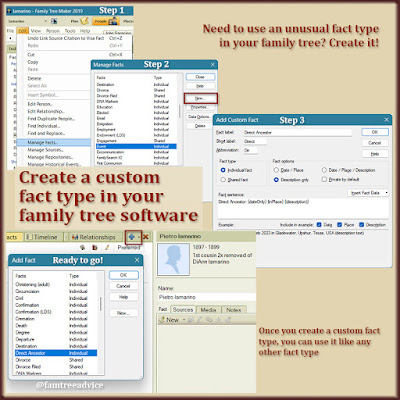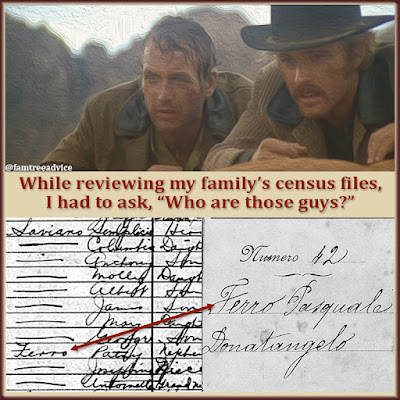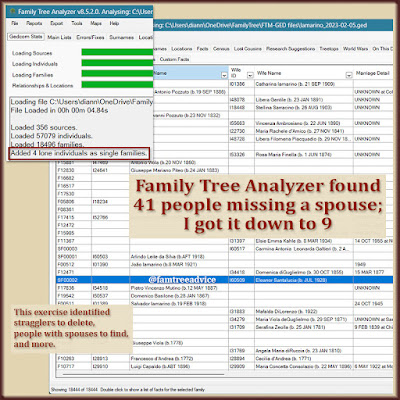I'm still busy making every source citation in my family tree complete and consistent. (See "Take the Time to Improve the Sources in Your Family Tree.") It's been so rewarding! Revisiting the documents and families tied to each citation shows me where I need more research. Sometimes it reminds me of past discoveries or problems.
One citation I reviewed was unique for my family tree. I realized I had a decision to make. I needed a custom fact type to handle a convict in the family.
 |
| You can create your own custom fact types in 3 steps with FamilyTree Maker. Your software should have this option, too. |
This one citation covered 3 images and facts belonging to a man name Frank. Frank's brother married my husband's aunt, and I'd forgotten about my past discovery. Frank committed an unspeakable crime and was sentenced to 7 years in prison.
- He went to San Quentin State Prison on 18 June 1942 at the age of 21.
- He was transferred to the prison in Chino, California, a year later.
- He was released on 18 March 1947 with parole.
How would you enter these dates in your family tree? It seems I assigned these dates to a fact type I made up—Internment. But that custom fact type is for Japanese family members the U.S. shipped off to the middle of nowhere during World War II.
I needed another fact type for Frank, so I created one called Imprisonment. Right now, only Frank uses this fact type, but I'm still reviewing my family tree.
Identifying Custom Fact Types
I wondered if I'd used Internment for other non-internment facts. To find out, I exported a new GEDCOM file and opened it with Family Tree Analyzer (FTA). On the Main Lists tab of FTA, I clicked the Custom Facts tab.
FTA showed me 7 custom fact types used in my tree:
- Ahnentafel—I think this fact type should be part of the GEDCOM standard. I use it to identify all my direct ancestors.
- AKA (Also Known As)—for entering nicknames. This is standard in Family Tree Maker, but FTA doesn't recognize it.
- Event—this is so generic. Too generic.
- Imprisonment
- Internment
- Passport Application
- Visa—some ship manifests include facts about travel visas.
While looking at this table in FTA, you can double-click any row to see who is using this fact type.
 |
| Don't know if you have any custom fact types in your tree? Use Family Tree Analyzer to spot them. |
I had one person using a fact type called Event. What the heck was that? I double-clicked the row to see the name, then I went to the person in my tree. Ironically, the Event was another man's prison stay. I guess I've struggled with how to categorize jail facts before. I switched this fact type from Event to Imprisonment.
There were 6 people with a custom fact type of Visa. Were these all visa applications for travelers? I double-clicked the Visa row, saw the names, and checked them out in my tree. Each one was a tiny entry pulled from a ship manifest. Obviously I don't add this fact to my tree routinely since there are only 6. But I'll leave them there in case these documents become available some day.
The 2 Passport Application facts were appropriate, but I know I have more than 2 passport applications. I'll bet I forgot I created a custom fact type for them!
The fact type that interests me most is the 35 people using the custom AKA fact type. I don't want to use AKA anymore. I've already started using a different style of recording name variations.
If they call someone by a different name on one census, I note it in the description field of their Residence fact for that year. My Aunt Elsie is a good example. I knew her all my life. I'm the baby she's holding in her profile photo in my tree. It came as a big surprise to discover her given name wasn't Elsie. It was Agnes! She's first called Elsie in the 1940 census, so that's where I've placed the name Elsie. It's in the description field of her 1940 Residence fact: "She is called Elsie."
 |
| Want to change how you record certain facts? Family Tree Maker can show you exactly where to find them. |
I've reviewed my 35 uses of the AKA fact type and dealt with them all in the proper description field.
This is what's nice about reviewing all your citations at once. You can bring every fact you've ever added to your tree up to your current standards.
Add or Delete Custom Fact Types
To add a new fact type in Family Tree Maker:
- Click the Edit menu and choose Manage Facts.
- In the Manage Facts window, click New to create a new fact type.
- Type in a descriptive fact label so you'll understand what it is. The program will create its short label and 3-letter abbreviation automatically.
- Choose whether to share the fact (like a marriage fact), or give it only to an individual.
- Choose what you intend to fill in. Do you want to have a date and place or only a description? You can even make this fact private by default.
- Click OK.
Now when you want to use this type of fact, you'll find it in the Add fact drop-down menu.
To delete an unused custom fact type in Family Tree Maker:
- Click the Edit menu and choose Manage Facts.
- In the Manage Facts window, select the fact type and click the Delete button.
- Click Yes to confirm, and the fact type is gone.
Uh oh. I'm seeing something for the first time in the Manage Facts window. You can select any fact type, click the Data Options button, and see a list of every fact you've assigned to that fact type. To my surprise, this method finds another 36 people using AKA. I need to update them with my new style.
As I was writing this article, Family Tree Maker released a free update affecting the Manage Relationships option on the Edit menu. (Find out everything new in this version 24.1 release.) I haven't explored any of the Manage options before because I had the wrong idea of what they were. Now I know what to write about next week.


